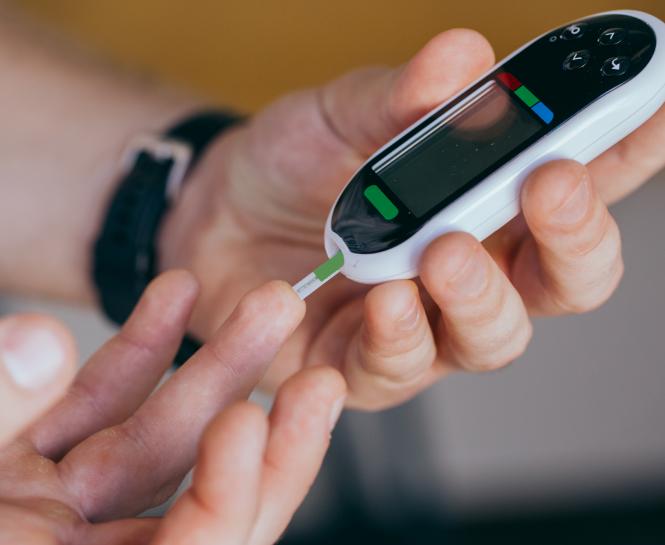Beth Freedman, manager of Outpatient Nutrition at the Diabetes Education Center at Mercy Hospital, shares essential information about prediabetes.
What is prediabetes?
Prediabetes is the precursor to type 2 diabetes—a “warning sign” that you could be looking at a diabetes diagnosis in the future. As we age and enter our early-to-mid 40s, our chances of developing prediabetes increase. And so do our risk factors. High blood pressure, cholesterol or triglycerides can also heighten your prediabetes risk.
Prediabetes is diagnosed as part of your routine bloodwork. Your primary care physician will order a bloodwork panel during your yearly physical, including an A1C test. This simple hemoglobin test measures your three-month blood sugar levels.
A1C results can fall into one of three categories:
- Normal range: A1C is below 5.7
- Prediabetes: A1C is between 5.7 - 6.4
- Type 2 diabetes: A1C of 6.5 or higher on two separate tests
An A1C in the prediabetes range is reversible; however, it’s a red flag to take action. Prediabetes can lead to a type 2 diabetes diagnosis, which is not reversible and must be managed daily throughout your lifetime.
What does a prediabetes diagnosis mean?
A higher-than-expected A1C result in the prediabetes range can be a shock. But don’t panic. Instead, take action. Because your A1C is a three-month cumulative measure of your blood glucose, your physician will repeat the bloodwork in three months. That means you have time to make changes that can impact that next A1C number.
When you retake your A1C test three months later:
- If your A1C is still in the prediabetes range, Your physician will continue to monitor your A1C approximately every three months as you work on lifestyle changes.
- If your A1C has lowered below the prediabetes range: You are no longer classified as prediabetic if your A1C has gone down, and your A1C will likely be rechecked at your annual well visit.
- If your A1C goes up but is still in the prediabetic range, Your physician will continue to monitor your A1C approximately every three months and recommend taking action on more lifestyle changes.
- If your A1C rises to the type 2 diabetes level: If your A1C is above the 6.5 threshold, it doesn’t mean you are immediately diagnosed with type 2 diabetes. Your physician will recheck your A1C. It takes two tests equal to or above the A1C of the 6.5 threshold for a diagnosis of type 2 diabetes.
Your primary care physician manages prediabetes. In complex cases, your physician may refer you to an endocrinologist, an expert in managing metabolic diseases like diabetes.
Are you at risk for diabetes?
Our quiz helps you make lifestyle choices that improve your health.
What is a prediabetes action plan?
If your A1C results show that you’re prediabetic, there is still time to make lifestyle changes to prevent it from becoming type 2 diabetes. Recommended prediabetes action plan ideas include:
- Change your diet. This is a hard one for all of us. But remember, it doesn’t have to be a complete overhaul. Add more fresh foods and cut back on processed white grains instead of whole grains. Eliminate sugary drinks, increase your water intake and monitor your portion size. Most adult-size carbohydrate portions are fist-sized, not full-plate-sized. Work with a dietician if you’d like in-depth training on meal planning, grocery shopping and carbohydrate counting.
- Create a workout schedule. Schedule a consultation with a trainer at a local gym, book a Zumba class or recruit a friend to be your daily walking buddy. Your goal should be to move your body for at least 150 minutes each week, which can be broken up into six daily 25-minute sessions. (With one rest day!) Even taking a ten-minute walk on your lunch break at work can make a difference.
- Inspire your family to join you. If you’re working to get healthier, bring your entire family along. As the obesity epidemic worsens, even children can be at risk of developing prediabetes and type 2 diabetes. Make it a fun family effort to discover new healthy recipes and fitness activities together.
- Lose a few pounds: Did you know the location of your weight can increase your chances of prediabetes? Extra weight around the stomach plays a significant role in prediabetes and diabetes risk, as does family history and genetics. Losing weight around your middle is a great place to start your fitness journey.
- Seek out helpful resources: Ask your physician for a referral to a prediabetes lifestyle change program, such as the National Diabetes Prevention Program, run through the CDC. You can also find many at-home workout options for free, like yoga or dance, on YouTube, prediabetes-specific recipe options and meal plans online.
Prediabetes is a warning sign for your health and an opportunity to change. You are more likely to achieve a healthy weight and enjoy a more active lifestyle with diet and exercise. So, take the plunge and get started today. Small changes can make a big difference, especially if you are prediabetic.
Find Care at Catholic Health
Call 866-MY-LI-DOC (866-695-4362) to find a Catholic Health physician near you. Explore our diabetes and endocrinology services.






